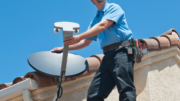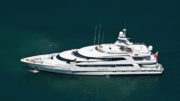Although most people get great reception with DIRECTV, there are a few places where the satellite service is considered a little less reliable. One is South Florida, where intense rainstorms come in most afternoons. While instances of “rain fade” are usually very short, that’s not enough for some customers who insist on 24/7 reliability.
That’s why one customer asked us:
Can you put up two DIRECTV dishes and get twice the signal? Can you combine them the way you combine antennas?
Quick answer: no.
You can combine the signals from two antennas by making sure the cables connecting them to the combiner are the same length. This avoids one signal getting there too early or too late. Unless the two signals arrive at the combiner at the same time, they can actually cancel each other out. That makes things worse, not better.
Unfortunately, you really can’t do the same thing with satellite signals. The two differences that stop you: the strength of the satellite signal and the size of the waves.
Satellite signals are very weak.
The signal from AT&T’s satellite starts out weaker than most terrestrial TV signals, and gets weaker as distances increase. This is a fact with any sort of signal, whether it’s light, sound, radio, or whatever. By the time the signal gets to your dish, it can be 1/10000th as strong as a typically received television signal. This makes combining a tough bet. The signal is only a tiny bit stronger than the noise surrounding it. Putting it through a combiner is going to add noise and that could potentially overwhelm the signal, even if it’s been amplified first.
Satellite signals also have really tiny waves.
Television signals have a wavelength measured in feet. Satellite signals have a wavelength measured in millimeters. This means you would have to be much, much more precise in order to combine. I would imagine the cables would have to be identical down to the tenth of a millimeter. This is, essentially, impossible.
But I hear you saying…

You’ve often seen multiple dishes up on a roof. DISH used to use up to three different ones, and DIRECTV uses two for international service. (For now…. they are rapidly moving to a one-dish solution there.)
The key is that you aren’t really “combining” signals at that point, you’re “diplexing.” The signals go into a multiswitch or special combiner that takes one frequency from one dish and one from another. This way the signals from the two dishes don’t interfere.
So what can be done to combat rain fade?
It’s not terribly popular to say, but there are going to be some rainstorms that you’ll never be able to see through. But, those are rare. When you look at the amount of time that satellite TV is down on average, it’s much less than cable. And, when satellite goes down it usually comes back up by itself.
In most cases, the best solution is simply to aim the dish really, really well. “Dithering” is the process of finding the exact center of the satellite beam, and with a properly dithered dish, it’s very rare to get rain fade for more than a minute or so. Adding an amplifier can help, but in order to get the best use out of an amp you will need a dish with multiple outputs. Those SWM-enabled dishes can’t be amplified.
Oh, and don’t even talk about the Alaska/Hawaii dish.
People inevitably bring up the dishes that are used in Alaska and Hawaii. They’re bigger than regular dishes and they use diplexing technology to allow you to use two of them. That’s all well and good but they don’t do a lot for mainlanders and are certainly not worth the work.





